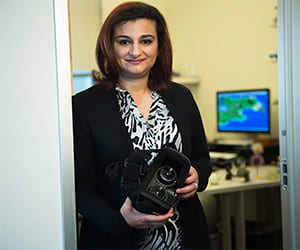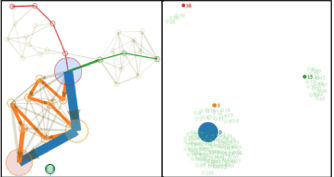
Machine learning uses data and algorithms to make predictions and perform learned tasks. Up until 2017, however, there had not been a machine learning application that studied the actual process of learning. But process mining, a new machine learning technique, changed that.
Process mining analyzes the methods behind problem solving and strategy to better understand and improve workflows in various applications. It started as a business analysis concept but is now gaining traction in a variety of industries such as retail, web design, and serious games.
Magy Seif El-Nasr, professor and department chair of computational media at the UC Santa Cruz Baskin School of Engineering, is applying this relatively new machine learning technique to her research in serious games to analyze how players solve problems and navigate through situations so she can improve the design and overall learning experience for the user.
“Everything in serious games is about problem solving,” Seif El-Nasr said. “We are either trying to change a behavior or are trying to have someone learn a new concept, so the individual learning process is a critical piece in game design.”

Process mining simplifies the steps needed for analysis, removing the need, in Seif El-Nasr’s case, to play back hours of video to analyze how a group of players are navigating the obstacles of a game. Drawing from data provided on the process a researcher wants to investigate, this technique computes insightful visualizations and analyses, outlining key areas for improvement.
Seif El-Nasr and researchers in her Game User Interaction and Intelligence (GUII) Lab have been interested in modeling player behavior to understand their learning strategies for quite some time. They developed a tool called Glyph to visualize player process and have been applying it to several of their games research projects.

Zhaoqing (Jimmy) Teng, one of Seif El-Nasr’s Ph.D. students, is currently building a new system called INSPECT, which builds on Glyph to include process mining techniques and additional features that improve the modeling of user behavior.
Seif El-Nasr aims to show the impact of this technique and its reach beyond games through case studies and additional publications. Then, she would like to transform the visualization framework into a software that can be adopted by other institutions and organizations and used for different applications.
“As far as I know, my lab is the only lab applying process mining to games research,” Seif El-Nasr said. “But the interest in this technique is growing, and I’d like to partner with other industries to apply it to their work.”
She is in the process of discussing this approach with several organizations, including the educational company Pearson. Most of Pearson’s educational materials are assessment-based and less geared toward understanding how individual students are learning the material. Seif El-Nasr is interested in applying process mining to help inform the creation of new educational materials that are accessible to all learners.
There is huge potential for this technique to transform organizational practices in a wide range of fields. To help promote process mining and its varying applications, Seif El-Nasr has given talks at several conferences and events. She most recently spoke at the process mining organization Fluxicon’s monthly cafe. Watch her talk to learn more about process mining, how her lab is applying it, and future applications.
– SHARE THIS STORY –
You May Also Be Interested In
-

2025 Dean’s Awards highlight outstanding Baskin Engineering undergraduate research in AI, cybersecurity, biomedicine, and more
-

Baskin Engineering students sweep SC Launchpad 2025 awards in technology and social impact categories
-

First annual UC Open Summit highlights open source innovation in the UC system

